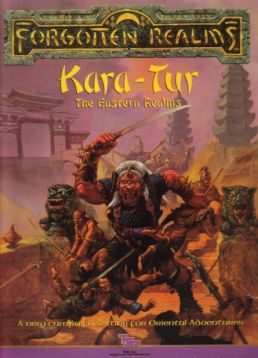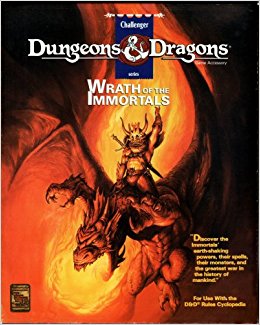Forgotten Realms is a campaign setting for the Dungeons & Dragons (D&D) fantasy role-playing game. Commonly referred to by players and game designers as "The Realms", it was created by game designer Ed Greenwood around 1967 as a setting for his childhood stories. Several years later, it was published for the D&D game as a series of magazine articles, and the first Realms game products were released in 1987. Role-playing game products have been produced for the setting ever since, in addition to novels, role-playing video game adaptations, comic books, and the film Dungeons & Dragons: Honor Among Thieves.

Mystara is a campaign setting for the Dungeons & Dragons fantasy role playing game. It was the default setting for the "Basic" version of the game throughout the 1980s and 1990s. Most adventures published for the "Basic" edition of D&D take place in "The Known World", a central continent that includes a varied patchwork of both human and non-human realms. The human realms are based on various real-world historical cultures. In addition, unlike other D&D settings, Mystara had ascended immortal beings instead of gods.
Hârn is a campaign setting for fantasy role-playing games, designed by N. Robin Crossby, and published by Columbia Games in 1983.

Mutants & Masterminds is a superhero role-playing game written by Steve Kenson and published by Green Ronin Publishing based on a variant of the d20 System by Wizards of the Coast. The game system is designed to allow players to create virtually any type of hero or villain desired.
Abeir-Toril is the fictional planet that makes up the Forgotten RealmsDungeons & Dragons campaign setting, as well as the Al-Qadim and Maztica campaign settings, and the 1st edition version of the Oriental Adventures campaign setting.

The Forgotten Realms Campaign Setting is a role-playing game sourcebook first published by TSR in 1987 for the first edition of the fantasy role-playing game Advanced Dungeons & Dragons that describes the campaign setting of the Forgotten Realms. It contains information on characters, locations and history. Various revised and updated editions have been produced over the years.

Engel is a role-playing game. The original German version uses a rule system in which the gamemaster and players draw associative, tarot-like cards instead of rolling dice to determine the outcome of an event. The English version of Engel does not include the Arcana system at all; it is based on the d20 System instead. The German version includes d20 rules in addition to the Arcana system. The game was published by the German publisher Feder&Schwert, who also published the World of Darkness RPG series in Germany and used to publish the Dungeons & Dragons series.

Spycraft is a d20 and OGL-based role-playing game dealing with superspies and modern action. Originally published by the Alderac Entertainment Group (AEG), it is currently published under licence by Crafty Games.
Atlas Games is a company which publishes role-playing games, board games and card games. Its founder and current president is John Nephew.
The flexibility of the Dungeons & Dragons (D&D) game rules means that Dungeon Masters (DM) are free to create their own fantasy campaign settings. For those who wanted a pre-packaged setting in which to play, TSR, Wizards of the Coast (WotC), and other publishers have created many settings in which D&D games can be based; of these, the Forgotten Realms, an epic fantasy world, has been one of the most successful and critically acclaimed settings. Many campaign settings include standard sword and sorcery environments, while others borrow Asian, Central American, swashbuckling, horror and even space-travel themes.

The Legend of the Five Rings Roleplaying Game is a role-playing game originally written by John Wick and published by Alderac Entertainment Group, under license from Five Rings Publishing Group, in 1997. The game uses the Legend of the Five Rings setting, primarily the nation of Rokugan, which is based on feudal Japan with influences from other East Asian cultures.
Scarred Lands is a post-apocalyptic fantasy campaign setting in which characters live in a world recovering from a devastating war between gods and titans. Initially published by White Wolf Publishing under its Sword & Sorcery brand using the d20 System, Scarred Lands is now owned by Onyx Path Publishing. In 2017 Onyx Path Publishing released an updated version of the setting using the 5th Edition Open Game License system along with a version of the core setting book using the first edition of the Pathfinder Roleplaying Game rules. Scarred Lands draws inspiration from Greek mythology.

Ptolus, subtitled "Monte Cook's City by the Spire", is a fantasy role-playing game campaign setting published by Malhavoc Press in 2006 that details a single city and the dungeons that lie beneath it. Ptolus uses the rules of the third edition of Dungeons & Dragons — the d20 System — under the terms of Wizards of the Coast's Open Game License. At 672 pages, it was the largest D&D supplement that had been published up to that time.
The legion of fictional deities in the World of Greyhawk campaign setting for the Dungeons & Dragons fantasy roleplaying game covers an extensive range of spheres of influence, allowing players to customize the spiritual beliefs and powers of their characters, and as well as giving Dungeon Masters a long list of gods from which to design evil temples and minions. Although the Greyhawk campaign world, when it was merely a home game, started with no specific gods, the value of having deities available for both players and game plot purposes was quickly realized. The number of deities has varied with each version of the campaign world that has been published, but for many years numbered a few dozen. It has only been since 1999 that the number of gods increased dramatically to almost 200, due to the volume of newly published material that was subsequently integrated into the campaign world.

Darwin's World, created by Dominic Covey, is a post-apocalyptic role-playing game first published under the d20 Open Game License in 2001. Originally designed as a quick adaptation of the 3rd Edition Dungeons & Dragons rules, the game has since been greatly expanded and revised and now utilizes the d20 Modern rules. Several Darwin's World books and supplements have seen print, though most support for the game is still only available in PDF format. In 2010, RPGObjects began producing game books using Pinnacle's Savage Worlds system.

A tabletop role-playing game, also known as a pen-and-paper role-playing game, is a classification for a role-playing game (RPG) in which the participants describe their characters' actions through speech, and sometimes movements. Participants determine the actions of their characters based on their characterization, and the actions succeed or fail according to a set formal system of rules and guidelines, usually containing Dice-Rolling. Within the rules, players have the freedom to improvise; their choices shape the direction and outcome of the game.

Kara-Tur: The Eastern Realms is an accessory and campaign setting for the Advanced Dungeons & Dragons fantasy role-playing game.

The Orcs of Thar is an accessory for the Dungeons & Dragons fantasy role-playing game, written by Bruce Heard and published by TSR in 1988.

Wrath of the Immortals, written by Aaron Allston, is a boxed set for the Dungeons & Dragons (D&D) fantasy role-playing game first published by TSR in 1992, revising the rules of the Immortals Rules box set that was originally released in 1986.












